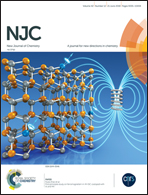Selective hydrazine sensor fabrication with facile low-dimensional Fe2O3/CeO2 nanocubes
Abstract
A facile hydrothermal technique was applied to prepare doped Fe2O3/CeO2 nanocubes (NCs) in alkaline medium at low temperature. The calcined NCs were characterized by Fourier-transform infrared spectroscopy (FTIR), ultraviolet visible spectroscopy (UV/vis), field emission scanning electron microscopy (FESEM), X-ray photoelectron spectroscopy (XPS), energy-dispersive X-ray spectroscopy (EDS), and powder X-ray diffraction (XRD). A chemical sensor was fabricated with a glassy carbon electrode (GCE) modified by deposition of a uniform thin layer of NCs film. The fabricated chemical sensor was used successfully to detect hydrazine selectively by a reliable electrochemical method at lower potential. The sensor's analytical performances, including good sensitivity (0.1275 μA μM−1 cm−2), low detection limit (7.45 ± 0.37 pM), broad linear dynamic range (0.02 μM–0.02 M), precious reproducibility, low limit of quantification (0.22 ± 0.01 μM) and long-term stability, were investigated. An efficient hydrazine chemical sensor based on Fe2O3/CeO2 NCs/binder/GCE was developed and performed well in terms of analytical sensing performances as well as being validated for environmental and extracted real samples.



 Please wait while we load your content...
Please wait while we load your content...